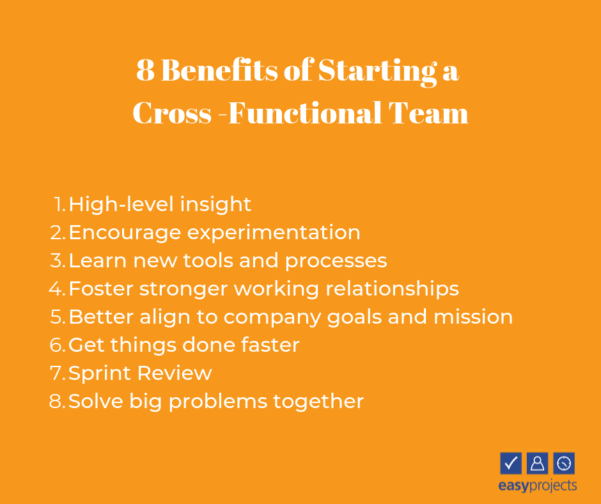Modern-day society is built on one thing: teamwork. Those who are able to work well together to get ahead and stay ahead.
When teams don‘t work well together, progress slows, innovation stalls, and big-picture goals often fall by the wayside. In fact, Harvard Business Review found that 75% of cross-functional teams are dysfunctional–primarily due to a lack of clear objectives and strong leadership. Yet, when done right, cross-functional teams can drive creativity, alignment, and efficiency, helping organizations tackle complex challenges and achieve their goals.
Let‘s explore the key factors that make cross-functional teams successful and the remarkable benefits they bring to businesses.
Here’s what happens when teams don’t work well together:
- Things progress slowly due to bottlenecks
- A lack of innovation due to siloed working conditions
- Misalignment to the goals and mission of the organization
- Skipping over big operational or process-oriented problems that need to be solved
Surprisingly, according to the Harvard Business Review, 75% of cross-functional teams are in fact, dysfunctional. So why is it worth pursuing the idea?
The reason why most cross-functional teams fail is that most organizations fail to launch a systematic approach that encompasses strong leadership and a clear objective.
What makes a successful cross-functional team?
The factors that contribute to a successful cross-functional team are:
- A shared goal
- Clearly defined roles
- Effective change-makers (able to facilitate and hold space for a change)
- Effective influencers (able to persuade key decision-makers)
These four factors help ensure that a cross-functional team is effective and can achieve the goal it was created to accomplish.
Why Cross-Collaborative Teams Matter
When teams operate in silos, their creative forces are stifled because there is only so much one team can come up with and execute on their own. Great companies know that creativity is the key to being competitive in the marketplace so they don’t allow teams to operate as lone-wolves. That’s why they form cross-functional teams.
MIT SMR and Deloitte’s survey of more than 3,500 managers found that “the most digitally advanced companies – those successfully deploying digital technologies and capabilities to improve processes, engage talent across the organization, and drive new value-generating business models – are far more likely to perform cross-functional collaboration.” – MIT SLOAN, APRIL 2019.
Cross-functional teams work well for all kinds of businesses and can include individuals from almost any department who will come together to accomplish a single goal. Without further adieu, here are the benefits of putting together a cross-functional team.
The 8 Benefits of Cross-Functional Teams
1. High-level insight
Cross-functional teams that are set up and run well can help foster change. This is not by accident. It’s because the level of insight they receive just by understanding what other departments are working on gives them the big picture. When you have the big picture, you gain clarity, and from clarity comes better decisions.
2. They encourage experimentation & innovation
Getting your team out of their comfort zones (singular department) helps them become more engaged and in doing so, they are able to look at problems from many perspectives. This leads to new ideas to explore and risks to take. If you want to get ahead of your competitors, pooling together the genius ideas of a cross-functional team is one way to do it.
Another advantage is that you’re able to release stuck creative energy in your team members. Stuck energy causes a lack of motivation and inspiration creating unhappiness and lower productivity.
3. Learn new tools
Cross-collaboration allows team members to be exposed to new tools being used by other teams. Teams can see how other teams use certain tools, processes, or methodologies to complete work which they can take back and try in their teams helping further increase productivity.
4. Foster stronger work relationships
Employee turnover is and will forever be an issue. But, if there is one thing that keeps people in a place longer against all odds, it’s having great relationships at work. Cross-functional teams allow people to venture out of their own departments and meet other people while gaining a sense of accountability toward their coworkers. When these bonds are strong, so is the health of any organization. People who like to work together tend to do great work because they understand who their work affects and how they can make a positive impact.
5. Improve communication skills
Forcing your team to communicate with a new group of people will help strengthen their skills in that arena. They will be hard put to the test and the result will (we hope) be positive. There is nothing more powerful than a group of people who can communicate well together.
6. Alignment to the company goals & mission
One of the biggest challenges companies often face is keeping all teams aligned with one mission and one vision for where they are headed. When teams begin to work cross-functionally, they are able to stay aligned simply because feel directly connected to the big picture. They can see how their efforts affect the work in another department and vice versa. This alignment leads to increased productivity and focus.
7. Get things done faster
When it comes to maximum productivity, cross-functional teams are the holy grail. The teams come up with new ideas, use new tools, and are able to execute quickly because of the free flow of information. No more bottlenecks, resource hold-ups, or miscommunication. In a world where strong teamwork determines the success of a business, cross-functional teams are a no-brainer.
8. Solve big problems
The most exciting thing about cross-functioning teams is that they can help solve larger organizational problems linked to processes. The unique perspectives they bring are golden nuggets of information that allow for problems that were overlooked to come to the surface. The perspectives will vary and clash, but you’ll end up with a scalable solution that satisfies everyone involved.
Cross-functional teams thrive with the right tools
Project management is all about bringing the right skills together in order to complete a project. Cross-functional project teams thrive when they have a central space to communicate and track their collective tasks and projects. A supportive team collaboration Project Management Software is one of the key components to make it work. With Birdview PSA, you can visually track cross-functional team progress via our Kanban board or Gantt view. Collaborate and manage cross-departmental resources with ease all while making the experience of working an exciting endeavor. If you’re ready to build your first cross-functional team, set everything up in Birdview PSA and reap the benefits.




